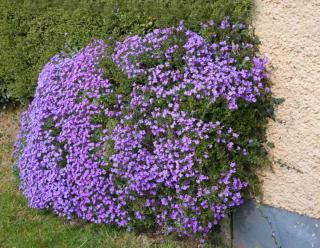

Pink, blue, violet, red or purple, mottled with gold or white, tiny aubrieta flowers are an enchantment in the garden when the spring sun first shines.
An ideal companion for bulb flowers, the small aubrieta corollas are part of the first wave of blooming in the garden.
From March to June, the flowery ground cover shows infinite variations and generously flows over edges, rocky ground and stone walls.
Aubrieta is a plant that is easy to grow. It copes well with chalky or limestone soil and easily withstands temperatures down to 5°F (-15°C).
Soil type doesn’t matter, and it quickly covers the ground when set in full sun. If ever it reaches spots of shade or was planted there intentionally, growth slows down and the blooming decreases.
It really joins in on creating a wonderful landscape, whether it grows between old, disjointed cobblestones, atop a sunny mound, or along an old stone wall… It’s also easy to create waterfalls of flowers for your balcony and suspended hanging pots. Let the stems fall over around the garden box to wrap it in flowers and hide the sides of it. Any container that is 6 to 8 inches (15 to 20 cm) deep will do.
You can also use aubrieta as a cover for certain deciduous shrubs, ideally those which tend to form a tall stem for which the base remains free. That will ensure the plant gets enough sunlight.
Apart from regular watering in summer when the weather gets hot, aubrieta really doesn’t need any care at all.

In summer, aubrieta sometimes tends to dry out, nothing to worry about! Remove parts that dry out after the blooming and cover the bunch with a bit of light soil mix.
When the plant starts growing sparse, it’s a sign that the plant is growing old. That’s when dividing the bunch is most appropriate. Operate after the blooming, pulling the plant out completely. Thread out the younger, densest clumps about 2 inches (5 cm) across and replant them immediately at a distance of about 8 inches (20 cm).
M.-C. D.